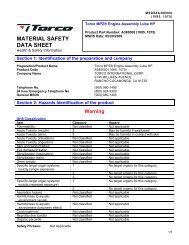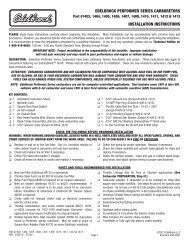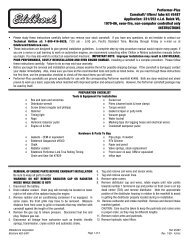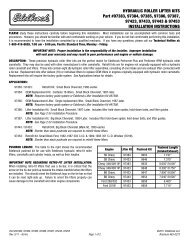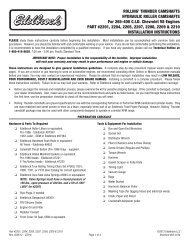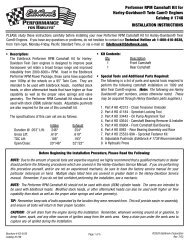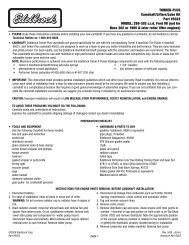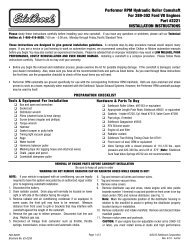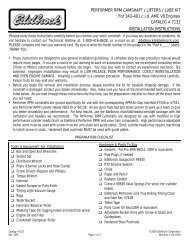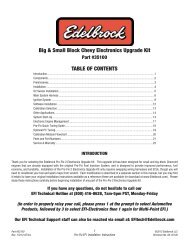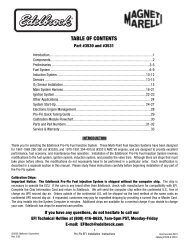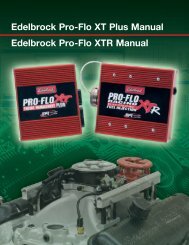1735 - Gear Drive Cam Set for Twin Cam H-D.qxd - Edelbrock
1735 - Gear Drive Cam Set for Twin Cam H-D.qxd - Edelbrock
1735 - Gear Drive Cam Set for Twin Cam H-D.qxd - Edelbrock
Create successful ePaper yourself
Turn your PDF publications into a flip-book with our unique Google optimized e-Paper software.
• Description:<br />
The <strong>Edelbrock</strong> Per<strong>for</strong>mer RPM <strong>Gear</strong> <strong>Drive</strong> <strong>Cam</strong>shaft Kit <strong>for</strong><br />
Harley-Davidson <strong>Twin</strong> <strong>Cam</strong> engines is designed to improve<br />
peak horsepower yet retain a broad torque range and<br />
improved rideability from 2800-6000+ RPM. Used in the<br />
<strong>Edelbrock</strong> Per<strong>for</strong>mer RPM Power Package, these cams have<br />
supported over 100hp at the wheel on a 95” <strong>Twin</strong> <strong>Cam</strong>. They<br />
are intended to be used with <strong>Edelbrock</strong> heads, modified stock<br />
heads, or other aftermarket heads that have higher air flow<br />
capability as well as the proper valve springs and valve<br />
geometry. The Per<strong>for</strong>mer RPM <strong>Cam</strong>shaft Kit should not be<br />
used with stock (OEM) cylinder heads. Adjustable pushrods<br />
are also required <strong>for</strong> the use of this camshaft kit.<br />
The specifications of this cam set are as follows:<br />
Intake Exhaust<br />
Duration @ .053” Lift: 246° 254°<br />
Gross Lift: .619” .619”<br />
TDC Lift: .188” .193”<br />
Open/Close: 20°/46° 52°/22°<br />
©2004 <strong>Edelbrock</strong> Corporation<br />
Rev. 6/04 - RS/mc<br />
Page 1 of 5<br />
Per<strong>for</strong>mer RPM <strong>Gear</strong> <strong>Drive</strong> <strong>Cam</strong>shaft Kit <strong>for</strong><br />
Harley-Davidson® <strong>Twin</strong> <strong>Cam</strong>® Engines<br />
Catalog # <strong>1735</strong><br />
INSTALLATION INSTRUCTIONS<br />
NOTE: DUE TO POSSIBLE FUTURE ENGINEERING CHANGES BY GEAR DRIVE MANUFACTURERS, THESE<br />
INSTRUCTIONS ARE INTENDED ONLY AS A GUIDE. PLEASE USE YOUR GEAR DRIVE MANUFACTURER’S<br />
INSTRUCTIONS AS YOUR PRIMARY SOURCE DURING THE INSTALLATION PROCEDURE.<br />
Be<strong>for</strong>e Beginning the Installation Procedure, Please Read the Following:<br />
CAUTION: IMPROPER INSTALLATION COULD RESULT IN ENGINE DAMAGE OR EVEN ENGINE SEIZURE, WHICH COULD RESULT IN<br />
SERIOUS INJURY TO THE RIDER OR OTHERS. Due to the amount of special tools and expertise required, we HIGHLY RECOMMEND<br />
that a qualified mechanic or dealer should per<strong>for</strong>m the following procedures which are covered in the Harley-Davidson Service<br />
Manual. If you are per<strong>for</strong>ming this procedure yourself, and/or are not an experienced mechanic, be sure to have the factory service<br />
manual <strong>for</strong> your particular motorcycle on hand. These instructions primarily cover the camshaft portion of the installation ONLY.<br />
Use your gear drive manufacturer’s instructions as your primary reference. Remember, if you do not feel confident per<strong>for</strong>ming the<br />
installation yourself, see a professional installer.<br />
NOTE: The Per<strong>for</strong>mer RPM <strong>Cam</strong>shaft Kit should not be used with stock (OEM) cylinder heads. The cams are intended to be used<br />
with <strong>Edelbrock</strong> heads. Modified stock heads, or other aftermarket heads can also be used (with higher air flow capability than<br />
stock as well as the proper valve springs and valve geometry). If other than <strong>Edelbrock</strong> cylinder heads and pistons are being used,<br />
valve to piston clearance must be checked be<strong>for</strong>e starting the engine. This is especially true if using stock heads and pistons.<br />
TIP: Remember, keep sets of bolts separated by the location they were removed from. This will provide easier re-assembly, and<br />
ensure all bolts will return to their proper location.<br />
CAUTION: Oil will drain from the engine during this installation. Remember, whenever working around oil or gasoline, to keep<br />
flame, spark, and any other sources of ignition away from the work area. Keep a drain pan under the work area to capture any<br />
oil spilled during the installation.<br />
PLEASE study these instructions carefully be<strong>for</strong>e installing your new Per<strong>for</strong>mer RPM <strong>Gear</strong> <strong>Drive</strong> <strong>Cam</strong>shaft Kit. If you have any<br />
questions or problems, do not hesitate to contact our Technical Hotline at: 1-800-416-8628, from 7am-5pm, Monday-Friday,<br />
Pacific Standard Time, or via e-mail at: <strong>Edelbrock</strong>@<strong>Edelbrock</strong>.com.<br />
• Kit Contents:<br />
Qty. Description<br />
1 Front <strong>Cam</strong>shaft<br />
1 Rear <strong>Cam</strong>shaft<br />
• Special Tools Required:<br />
The following is a list of special tools required to per<strong>for</strong>m the<br />
following camshaft installation on 1999 and later <strong>Twin</strong> <strong>Cam</strong>®<br />
engines. (Note: The following are Harley-Davidson® part<br />
numbers, unless otherwise noted. These may be acquired<br />
through Harley Davidson parts suppliers.)<br />
1. Part # HD 42313 - Chain Tensioner Unloader<br />
2. Part # 41184 - Sprocket Locking Tool<br />
3. Part # HD 33443 - Oil Pump Alignment Tool<br />
4. Part # HD 43644 - <strong>Cam</strong>shaft Bearing Remover & Installer<br />
5. Part # HD 42325 - Needle Bearing Remover & Installer<br />
6. Part # 262, 271, or 272 - Loctite Threadlocker (Red)<br />
7. Part # 242 or 243 - Loctite Threadlocker (Blue)<br />
8. Adjustable Pushrods (<strong>Edelbrock</strong> Part #1738<br />
Recommended)<br />
9. A Hydraulic Press<br />
(Additional parts may also be required, see gear drive<br />
manufacturer’s instructions <strong>for</strong> recommended installation parts).<br />
Catalog # <strong>1735</strong><br />
Brochure # 63-0286
1. Disconnect the battery, and remove the fuel tank.<br />
2. On engines with the oil tank above the engine, drain the<br />
engine oil.<br />
3. Remove the front exhaust pipe to clear the <strong>Cam</strong> Housing<br />
Cover.<br />
4. Remove the Rocker Covers and remove the four 5/16” bolts<br />
and the two 1/4” bolts holding the rocker arms in place.<br />
With the rocker arms removed, remove the stock pushrods.<br />
5. Remove the push rod tube retaining clips and push rod<br />
tubes.<br />
6. At this point, you may remove the lifter covers and take the<br />
lifters out, or you can make a lifter holding tool from a<br />
binder clip as shown in Figure 1.<br />
7. On pre-2000 models with a cam position sensor, you may<br />
want to remove the inspection cover, unplug the wires, and<br />
remove the sensor at this time to ease installation later on.<br />
8. Remove the cam housing cover keeping the bolts in a<br />
separate cup. (Note: Oil will run out of the cam housing.)<br />
9. Using the Chain Tensioner Unloader Tool, unload pressure<br />
on the outside chain tensioner, and pin it in place with the<br />
retaining pin (See Figure 2).<br />
Figure 2<br />
©2004 <strong>Edelbrock</strong> Corporation<br />
Rev. 6/04 - RS/mc<br />
Use wire from Binder<br />
Clip to hold lifters.<br />
INSTALLATION PROCEDURE<br />
Figure 1<br />
Sprocket<br />
Locking<br />
Tool<br />
Figure 3<br />
10. With the Sprocket Locking Tool in place, remove both<br />
sprocket retaining bolts (See Figure 3).<br />
11. Remove chain and sprockets. Remove the chain guide.<br />
12. Keeping your bolts separated, you are now ready to remove<br />
the bolts holding the oil pump and cam support plate<br />
assembly. Follow the sequence below, and alternately<br />
loosen and remove the oil pump bolts (See Figure 4-A).<br />
Page 2 of 5<br />
4<br />
13. Following the sequence below, alternately loosen and<br />
remove the cam support plate bolts (See Figure 4-B).<br />
14. With all bolts removed, remove the cam support plate and<br />
camshaft assembly. (Note: It is not necessary to remove<br />
the oil pump <strong>for</strong> this installation, unless grinding in the gear<br />
case is needed <strong>for</strong> clearancing. Be careful the oil pump<br />
rotors do not fall out. Remove support plate with care, and<br />
make sure the oil pump rotors are still in place after<br />
removal. If the rotors fall out, see your Factory Service<br />
Manual <strong>for</strong> assembly procedures. If clearancing is required,<br />
all gear case components must be removed, and all holes<br />
taped off to avoid contaminating the engine with debris.)<br />
15. Using the Chain Tensioner<br />
Unloader, retract the Secondary<br />
<strong>Cam</strong> Chain Tensioner, and pin it<br />
in place (See Figure 5).<br />
Keeping the bolts separate, you<br />
can now remove the four #20<br />
Torx screws holding the <strong>Cam</strong><br />
Bearing Retaining Plate.<br />
2<br />
1 3<br />
Figure 4-A<br />
Figure 5<br />
16. Place the <strong>Cam</strong> Support Plate/<strong>Cam</strong>shaft assembly into a<br />
press. Using the the <strong>Cam</strong>shaft/Bearing Remover and<br />
Installer, along with the proper support blocks, press the<br />
cams & bearings out of the support plate (See Figure 6).<br />
(Tip: Lightly heating the support plate around the bearing<br />
area can help ease the cams out of the support plate. In<br />
some cases, the cam bearings may have a loose fit in the<br />
cam support plate. <strong>Cam</strong>s and bearing assemblies may drop<br />
out when beginning to press out the assembly. If the<br />
camshafts are equipped with roller bearings, the cams will<br />
be loose and drop out.)<br />
5<br />
1<br />
3<br />
Hydraulic Press<br />
<strong>Cam</strong> <strong>Drive</strong>r<br />
6<br />
Figure 4-B<br />
Support Blocks<br />
2<br />
4<br />
Figure 6<br />
Catalog # <strong>1735</strong><br />
Brochure # 63-0286
17. Do not retain the snap ring from the front camshaft. <strong>Set</strong> the<br />
snap ring and cam chain aside (the snap ring and cam chain<br />
will not be reused). Use the Chain Tensioner Unloader to<br />
remove the retaining pin from each tensioner. Remove the<br />
retaining ring from each tensioner assembly and remove<br />
both assemblies from the cam support plate.<br />
NOTE: DO NOT reuse the original cam bearings. <strong>Edelbrock</strong> <strong>Gear</strong><br />
<strong>Drive</strong> <strong>Cam</strong>shafts require that ball bearings be used <strong>for</strong> both front<br />
and rear cam outer bearings. OEM type roller bearings used <strong>for</strong><br />
the rear camshaft in some stock engines have excessive internal<br />
clearance, allowing the center to center distance of the gears to<br />
vary. This causes excessive gear noise. Since gear drives do not<br />
exert a large side load on the rear camshaft, the higher load<br />
handling capacity of the roller type bearing is not required. Non-<br />
Roller Bearing kits can be obtained through the manufacturer of<br />
the gear drive being used.<br />
18. Apply assembly lube to the outer races of the new bearings<br />
(non-roller). Using the the <strong>Cam</strong>shaft Bearing Remover /<br />
Installer and proper support blocks (See Figure 7), press<br />
the new cam<br />
bearings into the<br />
cam support plate.<br />
19. Reinstall the <strong>Cam</strong><br />
Bearing Retaining<br />
Plate, making sure<br />
the threads of the<br />
Torx bolts are clean,<br />
using a drop of blue<br />
Loctite on the threads of each bolt. Torque the Torx bolts to<br />
20-30 inch lbs. (CAUTION: Bolts can break easily, torque<br />
only to the recommended torque value). Check the<br />
clearance between the cam bearing retaining plate and the<br />
woodruff keys that will<br />
secure the inner gears<br />
to the cams. Remove<br />
material from the<br />
retainer, if necessary, to<br />
achieve .030” of<br />
clearance between the<br />
key and the retainer<br />
(See Figure 8).<br />
©2004 <strong>Edelbrock</strong> Corporation<br />
Rev. 6/04 - RS/mc<br />
Hydraulic Press<br />
Bearing<br />
Installation<br />
Tool<br />
Support Blocks<br />
Figure 7<br />
Grind Here if Necessary<br />
Figure 8<br />
20. Press the camshaft gears onto the camshafts using a<br />
hydraulic press, using the proper assembly lube and the<br />
Woodruff keys supplied with your gear drive. Make sure<br />
timing marks on the gears face the camshaft lobes. (NOTE:<br />
See Figure 9. For further details on pressing the gears<br />
onto the camshafts, refer to the instructions provided by<br />
your gear drive’s manufacturer.)<br />
Page 3 of 5<br />
Figure 9<br />
21. Apply assembly lube to the inner race of the front bearing<br />
and to the outer bearing surface of the front camshaft<br />
(shorter). Support the bearing by the inner race, and press<br />
the cam all the wan into the bearing. Install a new snap ring<br />
onto the outer end of the front cam.<br />
22. Apply assembly lube to the bearing surface of the rear<br />
(longer) camshaft, and to the inner race of the rear bearing.<br />
Now carefully press the rear cam all the way into the<br />
bearing, supporting the bearing by the inner race. Make<br />
sure to align the gears as shown in Figure 10.<br />
Align<br />
Markings on<br />
<strong>Cam</strong>shafts<br />
As Shown<br />
Figure 10<br />
23. Carefully remove the camshaft inner needle bearings from<br />
the crankcase using the Needle Bearing Remover and<br />
Installer. Apply a small amount of assembly lube to the new<br />
bearings and install them into the crankcase. <strong>Cam</strong> bearings<br />
should be Torrington B148 full complement bearing or an<br />
equivalent.<br />
24. With the lifters held back, replace the cam support<br />
cover/camshaft assembly making sure all o-rings, seals,<br />
and oil pump parts are in place. The assembly should slide<br />
straight in and line up smoothly onto the cover locating pins<br />
on the cam cover sealing surface. Install two cam cover<br />
bolts. HAND-TIGHTEN ONLY .<br />
Catalog # <strong>1735</strong><br />
Brochure # 63-0286
25. Turn the splined end of<br />
the rear camshaft by<br />
hand to make sure the<br />
assembly spins freely. If<br />
you feel the cams<br />
interfering or rubbing on<br />
anything, remove the<br />
cam/cover assembly and<br />
check <strong>for</strong> interference<br />
with the engine case<br />
(See Figure 11 and grind only if necessary). If clearance<br />
is sufficient, remove the cover/cam assembly and apply a<br />
thin layer of assembly lube to the cam journals, lobe<br />
surfaces, and inner needle bearing surfaces, and re-install<br />
the assembly. Install the cover bolts (do not install the four<br />
(4) oil pump assembly bolts) tightening to 90-120 inch lbs.<br />
(Follow pattern from Figure 4-B). Use a small amount of<br />
Loctite 242 or 243 (blue) on the threads of the cover bolts.<br />
(CAUTION: Cover bolts that pass through alignment dowels<br />
can be easily stripped, use care when tightening, and only<br />
tighten to the recommended torque value.)<br />
26. Install the oil pump alignment tools (See Figure 12-A) into<br />
the # 3 & 4 holes in the cam support cover, HAND TIGHT<br />
ONLY (See Figure 12-B). While rotating the engine slowly,<br />
snug down the oil pump alignment pins. Install bolts into<br />
the # 1 & 2 holes in the cam cover and tighten to 90-100<br />
inch lbs. Remove the alignment tools and install the bolts<br />
into the # 3 & 4 holes, tighten to 90-100 inch lbs. using a<br />
drop of Loctite 242 or 243 (Note: While rotating engine,<br />
make sure oil comes out of the cam support cover. This will<br />
indicate the oil pump is properly installed.).<br />
Oil Pump<br />
Alignment Tools<br />
27. Place the crankshaft gear on the crankshaft with the timing<br />
mark facing outward. Apply a drop of Loctite Threadlocker<br />
262, 271, or 272 (red) to the threads of a new crankshaft<br />
gear bolt (usually supplied in the gear drive manufacturer’s<br />
installation kit, or obtained through a dealer). Apply a drop<br />
of 20W-50 engine oil under the bolt flange, and using the<br />
stock crank sprocket washer, install the crankshaft gear.<br />
Torque the crankshaft gear bolt to 25 ft/lbs.<br />
©2004 <strong>Edelbrock</strong> Corporation<br />
Rev. 6/04 - RS/mc<br />
If Clearance is<br />
Inadequate, Grind<br />
Here<br />
1<br />
4<br />
Figure 11<br />
Figure 12-A Figure 12-B<br />
2<br />
3<br />
Page 4 of 5<br />
28. Rotate the engine until the timing mark on the crankshaft<br />
gear is in position (See Figure 13). Place the drive gear<br />
key into the rear camshaft. Place the camshaft gear onto<br />
the cam and key, with the timing mark facing outward.<br />
Rotate the camshaft gear until the cam and crank gear<br />
timing marks are aligned properly (See Figure 13). Using<br />
a drop of Loctite Threadlocker 262, 271, or 272 (red) on the<br />
threads of the camshaft drive gear bolt, and using the<br />
washer supplied with your gear drive, install the cam gear<br />
bolt, tightening to 34 ft/lbs.<br />
Figure 13<br />
NOTE: The crankshaft gear and camshaft gear have a light press<br />
fit. Make sure gears are started squarely on the shafts, and use<br />
the mounting bolts to pull them into position.<br />
29. Check the clearance between the cam drive gear, and the<br />
cam housing cover. Place a small piece of clay or putty on<br />
the housing cover mounting boss (See Figure 14). Place<br />
the cam housing cover onto the engine (with gasket in<br />
place) and install four of the mounting bolts near the<br />
corners of the cover, finger tighten. Push or tap the cover<br />
towards the front of the engine.<br />
30. Carefully remove the cover. Measure the amount of clay<br />
between the gear and the cover mounting boss at its<br />
thinnest point. There should be at least .030” clearance.<br />
Remove a small amount of material from the cover<br />
mounting boss (if necessary) to achieve the necessary<br />
clearance. DO NOT REMOVE more material than<br />
necessary. Use<br />
care not to break<br />
through to the<br />
outside of the<br />
.030” Minimum<br />
cover. Damage<br />
to the cover from<br />
removal of too<br />
much material is<br />
NOT covered<br />
Figure 14<br />
under warranty.<br />
Catalog # <strong>1735</strong><br />
Brochure # 63-0286
9<br />
5<br />
1<br />
3<br />
7 6<br />
31. Re-install the cam housing cover. Tighten the cover bolts to<br />
90-120 Inch Lbs. (See Figure 15).<br />
32. You are now ready to install and adjust the pushrods. Begin<br />
by making sure the pushrods are clean, and adjusted to<br />
their shortest length possible. The shorter pushrods are <strong>for</strong><br />
the intake valves and the longer pushrods are <strong>for</strong> the<br />
exhaust.<br />
33. Insert the pushrods <strong>for</strong> one cylinder (one intake, one<br />
exhaust) into their proper locations on the rear cylinder. Do<br />
not install the pushrod tubes at this time. Rotate the engine<br />
until the lifters <strong>for</strong> the rear cam are on the base circle of the<br />
camshaft (lowest point). Install the rocker arm assembly <strong>for</strong><br />
the rear cylinder, making sure the ball of each pushrod is in<br />
the cup of its corresponding rocker arm. Snug the rocker<br />
arm bolts to 18 ft/lbs.<br />
34. Adjust the pushrods out until all free play is taken up<br />
between the rocker arms and lifters. This is zero lash. Do<br />
not adjust beyond this point.<br />
35. Use a paint pen or marker and mark this point on the<br />
pushrods. (see Figure 16). Extend the pushrods 3-1/2<br />
turns (18 flats on the adjusting hex). Remove the rocker<br />
assembly and remove the pushrods. Make sure to keep the<br />
pushrods in order and at their current adjustment.<br />
36. Using new o-rings, install the pushrod tubes. Do not extend<br />
the pushrod tubes at this time. Insert the pushrods back<br />
into their proper location. Re-install the rocker arms,<br />
tightening the bolts to 18-22 ft/lbs. Install the breather<br />
plates, tightening the 1/4” bolts to 90-100 inch lbs. You may<br />
now extend the pushrod tubes and lock into place with the<br />
pushrod tube clips.<br />
©2004 <strong>Edelbrock</strong> Corporation<br />
Rev. 6/04 - RS/mc<br />
Tighten Bolts<br />
to<br />
90-120<br />
Inch Lbs.<br />
Figure 15<br />
Page 5 of 5<br />
Figure 16<br />
37. Coat the rocker arms in clean engine oil. Install the rocker<br />
cover (Note: You may need to grind the rocker cover <strong>for</strong><br />
clearance, especially if using roller rockers, see<br />
Figure 17).<br />
Grind Ribs Shown<br />
by Arrows<br />
Mark Pushrods<br />
as Shown<br />
Figure 17<br />
38. Wait at least 20 minutes to let the lifters bleed down, then<br />
repeat the pushrod adjustment covered in steps 29 through<br />
35 on the front cylinder.<br />
Please fill out and return your warranty card. Be sure to write the part number in the “Part #____” space. Thank you.<br />
The words <strong>Twin</strong> <strong>Cam</strong>, Harley, and Harley-Davidson are registered<br />
trademarks of Harley-Davidson, Inc., Milwaukee, Wisconsin, USA, and are<br />
used in this instruction sheet <strong>for</strong> reference only.<br />
2<br />
8<br />
4<br />
10<br />
<strong>Edelbrock</strong> Corporation, 2700 Cali<strong>for</strong>nia St., Torrance, CA 90503<br />
Tech Line: 1-800-416-8628 • Office: 310-781-2222<br />
Tech Fax: 310-972-2730 • E-Mail: <strong>Edelbrock</strong>@<strong>Edelbrock</strong>.com<br />
<strong>Edelbrock</strong> is a registered trademark of <strong>Edelbrock</strong> Corporation<br />
2700 Cali<strong>for</strong>nia St., Torrance, CA 90503, USA<br />
Catalog # <strong>1735</strong><br />
Brochure # 63-0286



